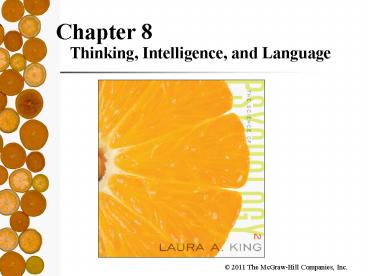Chapter 8 Thinking, Intelligence, and Language - PowerPoint PPT Presentation
1 / 35
Title:
Chapter 8 Thinking, Intelligence, and Language
Description:
Chapter 8 Thinking, Intelligence, and Language IM: Biological and Environmental Influences on Language Activity * IM: Language and Education Activity * IM: Types of ... – PowerPoint PPT presentation
Number of Views:1108
Avg rating:3.0/5.0
Title: Chapter 8 Thinking, Intelligence, and Language
1
- Chapter 8Thinking, Intelligence, and Language
2
Chapter Preview
- Cognitive Revolution in Psychology
- Thinking
- Intelligence
- Language
- Thinking, Problem-Solving, and Health and Wellness
3
The Cognitive Revolution
- cognition how information is processed and
manipulated when remembering, thinking, and
knowing - 1950s psychology resumes focus on the mind and
mental processes - computers an analogy for the mind/brain
- - artificial intelligence (AI)
4
The Computer Analogy
5
Thinking
- concepts mental categories used to group
objects, events, and characteristics - prototype model all instances of a concept are
compared to a prototype (ideal example) of that
concept
6
Steps in Problem Solving
- Find and frame problem
- Develop good problem-solving strategies
(subgoals, algorithms, heuristics) - Evaluate solutions
- Rethink and redefine problems and solutions over
time
7
Problem-Solving Obstacles
- fixation
- - using a prior strategy only
- functional fixedness
- - fixated on usual functions
8
Reasoning
- mental activity of transforming information to
reach conclusions - inductive reasoning
- - driven by data bottom-up specific ? general
- deductive reasoning
- - driven by logic top-down general ? specific
9
Reasoning and Decision Making
10
Decision Making
- evaluating alternatives and making choices among
them - attempting to maximize outcome
11
Reasoning and Decision Making
- System I automatic
- rapid, heuristic, intuitive
- System II controlled
- slower, effortful, analytical
12
Decision-Making Biases
- Confirmation Bias
- search only for info that supports our ideas
- Hindsight Bias
- report falsely that we predicted an outcome
- Availability Heuristic
- predict probability based on ease of recall
- Base-Rate Fallacy
- ignore info about general principles
- Representativeness Heuristic
- make judgments based on stereotypes
13
Critical Thinking
- thinking reflectively and productively and
evaluating the evidence - mindfulness alert and mentally present
- open-mindedness receptive to new ways of
looking at things
14
Emotion and Cognition
- moods influence the way we think
- bad moods gtgt use careful logic to solve problems
- good moods gtgt efficiency, originality,
creativity, ignore irrelevant info
15
Creative Thinking
- Divergent versus Convergent Thinking
- Characteristics of Creative Thinkers
- brainstorm
- flexibility and playful thinking
- inner motivation
- willingness to face risk
- objective evaluation of work
16
Intelligence
- What is intelligence?
- definitions of intelligence reflect culture
- U.S. Spearmans g
- measuring intelligence
- - validity
- - reliability
- - standardization
17
Intelligence Tests Criteria
18
Intelligence Tests
- Binet Mental Age (MA)
- Stern Intelligence Quotient (IQ)
- normal distribution
- Stanford-Binet Test
19
Intelligence Normal Distribution
20
Influences on Testing
- Cultural Bias in Testing
- culture-fair tests (e.g., Raven Progressive
Matrices) - Genetic Influences on Intelligence
- heritability
- increases with age
- Environmental Influences on Intelligence
- Flynn effect
21
The Flynn Effect
22
Variations in Intelligence
- Giftedness usually IQ 130
- Terman socially well adjusted and successful as
adults - importance of innate ability
- Intellectual disability usually IQ lt 70
- organic versus cultural-familial disabilities
- mild, moderate and severe/profound
- adaptive behavior deficits (conceptual, social,
practical)
23
Theories of Multiple Intelligences
- Sternbergs Triarchic Theory
- analytical intelligence
- creative intelligence
- practical intelligence
24
Theories of Multiple Intelligences
- Gardners Frames of Mind
- verbal mathematical
- spatial bodily-kinesthetic
- interpersonal intrapersonal
- naturalist existentialist
- musical
25
Language
- Language
- form of spoken, written, or signed
communication based on symbols - Infinite Generativity
- ability to produce an endless number of
meaningful sentences
26
Structure of Language
- Phonology - basic phonemes (sounds)
- Morphology - rules for word formation
- Syntax - rules for combining words to form
phrases and sentences - Semantics - meaning of words and sentences
- Pragmatics - use of language
27
Language and Cognition
- Can you think without using language?
- Whorfs linguistic relativity hypothesize
- language determines thought
- role of cognition in language
- role of language in cognition
28
Gender and Language
- Gender Differences in Language
- Are women more talkative?
29
Influences on Language
- Biological Influences
- language universals
- hemispheric specialization
- Environmental Influences
- behavioral view (learned skill)
- language exposure (case of Genie)
30
Development of Language
31
Learning a Second Language as an Adult
- Sensitive Periods in Language Learning
- new sounds/accent and new grammar
- new vocabulary
32
Thinking, Problem-Solving, and Health and Wellness
- Cognitive Appraisal and Coping
- primary appraisal
- secondary appraisal
- cognitive reappraisal
33
Chapter Summary
- Describe cognitive psychology and discuss the
role of the computer in the development of the
field. - Explain the processes and human limitations in
problem solving, reasoning, and decision making. - Describe intelligence and its measurement.
- Discuss influences on intelligence and types of
intelligence. - Identify the connections between language and
thought and summarize how language is acquired
and develops. - Discuss the importance of cognitive appraisal
with respect to stress and describe various
styles of coping.
34
Chapter Summary
- Cognitive Revolution
- Thinking
- prototype model of concepts
- problem-solving steps and barriers
- reasoning and decision making
- - inductive, deductive, and intuitive
- - biases
- critical and creative thinking
35
Chapter Summary
- Intelligence
- IQ tests measurement, Binet, normal curve
- influences on intelligence test scores
- extremes and types of intelligence
- Language
- structure, development, and influences
- Thinking, Problem-Solving, and Health and
Wellness - cognitive appraisal and coping strategies

